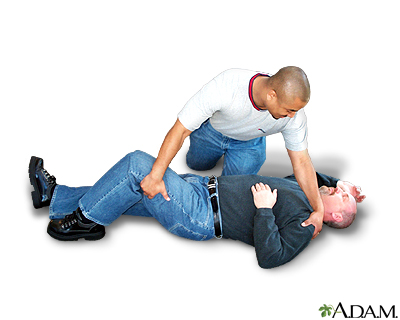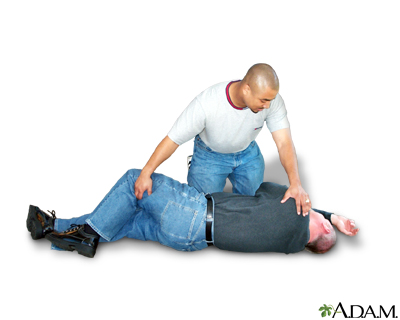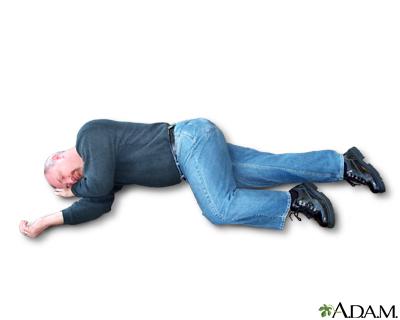Unconsciousness - first aid
Loss of consciousness - first aid; Coma - first aid; Mental status change; Altered mental status; Syncope - first aid; Faint - first aidUnconsciousness is when a person is unable to respond to people and activities. Health care providers often call this a coma or being in a comatose state.
Coma
Decreased alertness is a state of reduced awareness and is often a serious condition. A coma is the most severe state of decreased alertness from whi...
Read Article Now Book Mark ArticleOther changes in awareness can occur without becoming unconscious. These are called altered mental status or changed mental status. They include sudden confusion, disorientation, or stupor.
Unconsciousness or any other sudden unexplained change in mental status must be treated as a medical emergency.
Causes
Unconsciousness can be caused by nearly any major illness or injury. It can also be caused by substance (medicine or drug) and alcohol use. Choking on an object can result in unconsciousness as well.
Choking on an object can result in unco...
Choking is when someone cannot breathe because food, a toy, or other object is blocking the throat or windpipe (airway). A choking person's airway ma...

Brief unconsciousness (or fainting) is often a result from dehydration, low blood sugar, or temporary low blood pressure. It can also be caused by serious heart or nervous system problems. A provider can determine if the affected person needs tests to diagnose their fainting.
Fainting
Fainting is a brief loss of consciousness due to a drop in blood flow to the brain. The episode most often lasts less than a couple of minutes and y...
Read Article Now Book Mark ArticleLow blood sugar
Low blood sugar is a condition that occurs when the body's blood sugar (glucose) decreases and is too low. Blood sugar below 70 mg/dL (3. 9 mmol/L) i...

Other causes of fainting include straining during a bowel movement or urination, coughing very hard, breathing very fast (hyperventilating), or vasovagal syncope.
Hyperventilating
Hyperventilation is rapid and deep breathing. It is also called overbreathing, and it may leave you feeling breathless.

Symptoms
The person will be unresponsive (does not respond to activity, touch, sound, or other stimulation).
The following symptoms may occur after a person has been unconscious:
- Amnesia (not remembering) for events before, during, and even after the period of unconsciousness
Amnesia
Memory loss is unusual forgetfulness. You may not be able to remember new events, recall one or more memories of the past, or both. The memory loss ...
 ImageRead Article Now Book Mark Article
ImageRead Article Now Book Mark Article - Confusion
- Drowsiness
Drowsiness
Drowsiness refers to feeling more sleepy than normal during the day. People who are drowsy may fall asleep when they do not want to or at times whic...
 ImageRead Article Now Book Mark Article
ImageRead Article Now Book Mark Article - Headache
- Inability to speak or move parts of the body (stroke symptoms)
Stroke
A stroke occurs when blood flow to a part of the brain stops. A stroke is sometimes called a "brain attack. " If blood flow is cut off for longer th...
 ImageRead Article Now Book Mark Article
ImageRead Article Now Book Mark Article - Lightheadedness
- Loss of bowel or bladder control (incontinence)
- Rapid heartbeat (palpitations)
Palpitations
Palpitations are feelings or sensations that your heart is pounding or racing. They can be felt in your chest, throat, or neck. You may:Have an unpl...
 ImageRead Article Now Book Mark Article
ImageRead Article Now Book Mark Article - Slow heartbeat
- Stupor (severe confusion and weakness)
Stupor
Decreased alertness is a state of reduced awareness and is often a serious condition. A coma is the most severe state of decreased alertness from whi...
Read Article Now Book Mark Article
If the person is unconscious from choking, symptoms may include:
- Inability to speak
- Difficulty breathing
- Noisy breathing or high-pitched sounds while inhaling
- Weak, ineffective coughing
- Bluish skin color (cyanosis)
Bluish skin color
A bluish color to the skin or mucous membrane is usually due to a lack of oxygen in the blood. The medical term is cyanosis.
 ImageRead Article Now Book Mark Article
ImageRead Article Now Book Mark Article
Being asleep is not the same as being unconscious. A sleeping person will respond to loud noises or gentle shaking. An unconscious person will not.
First Aid
If someone is awake but less alert than usual, ask a few simple questions, such as:
- What is your name?
- What is the date?
- How old are you?
Wrong answers or not being able to answer the question suggest a change in mental status.
If a person is unconscious or has a change in mental status, follow these first aid steps:
Call or tell someone to call 911 or the local emergency number.
- Check the person's airway, breathing, and pulse frequently. If necessary, begin CPR.
CPR
CPR stands for cardiopulmonary resuscitation. It is an emergency life-saving procedure that is done when someone's breathing or heartbeat has stoppe...
Read Article Now Book Mark Article - If the person is breathing and lying on their back, and you do not think there is a spinal injury, carefully roll the person toward you onto their side. Bend the top leg so both hip and knee are at right angles. Gently tilt their head back to keep the airway open. If breathing or pulse stops at any time, roll the person onto their back and begin CPR.
Spinal injury
The spinal cord contains the nerves that carry messages between your brain and the rest of the body. The cord passes through your neck and back. A ...
 ImageRead Article Now Book Mark Article
ImageRead Article Now Book Mark Article - If you think there is a spinal injury, leave the person where you found them (as long as breathing continues). If the person vomits, roll the entire body at one time to their side. Support their neck and back to keep the head and body in the same position while you roll.
- Keep the person warm until medical help arrives.
- If you see a person fainting, try to prevent a fall. Lay the person flat on the floor and raise their feet about 12 inches (30 centimeters).
- If fainting is likely due to low blood sugar, give the person something sweet to eat or drink only when they become conscious.
Low blood sugar
Low blood sugar is a condition that occurs when the body's blood sugar (glucose) decreases and is too low. Blood sugar below 70 mg/dL (3. 9 mmol/L) i...
 ImageRead Article Now Book Mark Article
ImageRead Article Now Book Mark Article
If the person is unconscious from choking:
- Begin CPR. Chest compressions may help dislodge the object.
CPR
CPR stands for cardiopulmonary resuscitation. It is a lifesaving procedure that is done when someone's breathing or heartbeat has stopped. This may...
 ImageRead Article Now Book Mark Article
ImageRead Article Now Book Mark Article - If you see something blocking the airway and it is loose, try to remove it. If the object is lodged in the person's throat, do not try to grasp it. This can push the object farther into the airway.
- Continue CPR and keep checking to see if the object is dislodged until medical help arrives.
Do Not
- Do not give an unconscious person any food or drink.
- Do not leave the person alone.
- Do not place a pillow under the head of an unconscious person.
- Do not slap an unconscious person's face or splash water on their face to try to revive them.
When to Contact a Medical Professional
Call 911 or the local emergency number if the person is unconscious and:
- Does not return to consciousness quickly (within a minute)
- Has fallen down or been injured, especially if they are bleeding
- Has diabetes
- Has seizures
- Has lost bowel or bladder control
- Is not breathing
- Is pregnant
- Is over age 50
Call 911 or the local emergency number if the person regains consciousness, but:
- Feels chest pain, pressure, or discomfort, or has a pounding or irregular heartbeat
- Cannot speak, has vision problems, or cannot move their arms and legs
Prevention
To prevent becoming unconscious or fainting:
- Avoid situations where your blood sugar level gets too low.
Blood sugar level
A blood sugar test measures the amount of sugar (glucose) in a sample of your blood. Glucose is a major source of energy for most cells of the body, ...
 ImageRead Article Now Book Mark Article
ImageRead Article Now Book Mark Article - Avoid standing in one place too long without moving, especially if you are prone to fainting.
- Get enough fluid, particularly in warm weather.
- If you feel like you are about to faint, lie down or sit with your head bent forward between your knees.
If you have a medical condition, such as diabetes, always wear a medical alert necklace or bracelet.
Diabetes
Diabetes is a long-term (chronic) disease in which the body cannot regulate the amount of sugar in the blood.

References
Hewett Brumberg EK, Douma MJ, Alibertis K, et al. American Heart Association and American Red Cross. 2024 American Heart Association and American Red Cross guidelines for first aid. Circulation. 2024;150(24):e519-e579. PMID: 39540278 pubmed.ncbi.nlm.nih.gov/39540278/.
Lei C, Smith C. Depressed consciousness and coma. In: Walls RM, ed. Rosen's Emergency Medicine: Concepts and Clinical Practice. 10th ed. Philadelphia, PA: Elsevier; 2023:chap 12.
Perman SM, Elmer J, Maciel CB, et al. 2023 American Heart Association focused update on adult advanced cardiovascular life support: An update to the American Heart Association guidelines for cardiopulmonary resuscitation and emergency cardiovascular care. Circulation. 2023;149(5):e254-e273. PMID: 38108133 pubmed.ncbi.nlm.nih.gov/ 38108133/.
Probst M. Syncope. In: Walls RM, ed. Rosen's Emergency Medicine: Concepts and Clinical Practice. 10th ed. Philadelphia, PA: Elsevier; 2023:chap 11.
Review Date: 1/8/2025
Reviewed By: Jesse Borke, MD, CPE, FAAEM, FACEP, Attending Physician at Kaiser Permanente, Orange County, CA. Also reviewed by David C. Dugdale, MD, Medical Director, Brenda Conaway, Editorial Director, and the A.D.A.M. Editorial team.





